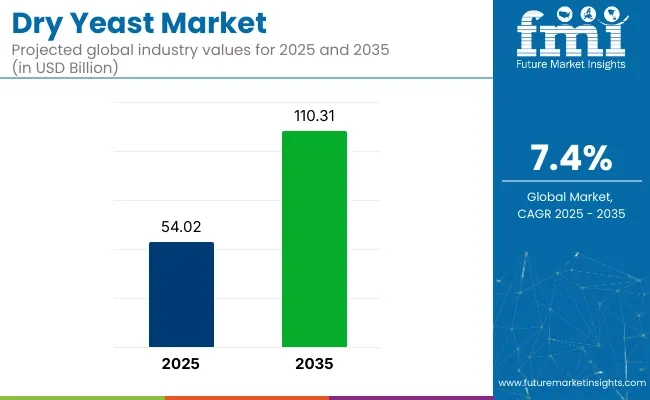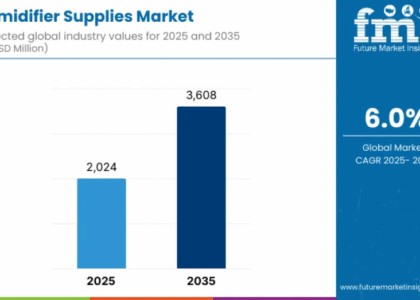
Once relegated to the back of the pantry and rarely mentioned outside of bakery circles, dry yeast is now proving itself to be one of the most quietly powerful forces in the global food supply chain. In a world craving both consistency and convenience, this unassuming ingredient is on track for a breakout decade.
According to Future Market Insights, the dry yeast market is projected to grow from approximately USD 54 billion in 2025 to nearly USD 110.3 billion by 2035, registering a compound annual growth rate (CAGR) of 7.4%. That’s not just growth—it’s a doubling of market value over ten years for a product many consumers barely think about.
This isn’t just about bread. It’s about the future of food resilience.
Stay Ahead with Market Trends: Access Your Sample Report Now: https://www.futuremarketinsights.com/reports/sample/rep-gb-12013
Pandemic-Era Habits Are Now Structural Shifts
The COVID-19 pandemic sparked an unexpected revival in home baking, but more importantly, it reshaped global attitudes toward food storage, self-reliance, and shelf-stable ingredients. Dry yeast, with its long life and flexibility, became a symbol of smart, adaptable consumption.
Now, the surge isn’t coming from hobbyists—it’s being driven by industrial-scale bakeries, foodservice chains, and emerging economies looking to build stability into their food systems.
Rising Interest in Market Trends: Our Detailed Report Provides Essential Insights: https://www.futuremarketinsights.com/reports/dry-yeast-market
A Global Ingredient for a Global Problem
As inflation continues to pressure grocery costs and fresh supply chains remain fragile, dry yeast’s appeal is obvious: it’s reliable, compact, transportable, and essential to both traditional and modern food manufacturing.
Markets in Asia and Africa are expected to play a significant role in accelerating growth, while North America and Europe continue to scale up production in response to heightened demand. Dry yeast is no longer a niche—it’s a strategic staple.
Beyond Bread: A Microbial Powerhouse
The uses of dry yeast are evolving far beyond the bread aisle. It’s becoming a critical input in multiple verticals—from biofuel fermentation to alternative protein production. Its microbial versatility gives it utility in food tech and biotech, making it not just relevant, but indispensable.
As the line between food and functional ingredients blurs, yeast sits at the intersection of tradition and innovation.
Time to Respect the Basics
In a food industry obsessed with flashy trends and “disruptive” ingredients, dry yeast stands out for what it doesn’t need: hype. It doesn’t promise to revolutionize your diet overnight—it just works. Quietly. Efficiently. Globally.
According to Future Market Insights, that’s exactly the kind of ingredient the world is investing in now. A 7.4% annual growth rate isn’t just impressive—it’s a sign that reliable, essential inputs are finally being valued for what they are: infrastructure.
Final Thought: The Rise Is Just Beginning
Dry yeast may never trend on social media or headline glossy food expos, but its economic footprint is expanding fast. And as global demand rises for reliable, scalable ingredients, this pantry staple may soon become a cornerstone of the food industry’s next chapter.
Sometimes the most important innovations are the ones that were there all along—quietly waiting to rise.
Competition Analysis
- Kerry Group
- Bio Springer S.A
- Koninklijke DSM N.V.
- Lallemand Inc
- Sensient Technologies Corporation
- Leiber GmbH
- KOHJIN Life Science Co., Ltd
- Angel Yeast Co., Ltd
- Titan Biotech Ltd
- Associated British Foods Plc
Explore Functional Food Ingredients Industry Analysis: https://www.futuremarketinsights.com/industry-analysis/functional-food-ingredients
Key Segments
By Product Type:
- Active Dry Yeast
- Inactive Dry Yeast
By Form:
- Powder
- Flakes
By Base:
- Fortified
- Unfortified
By Nature:
- Organic
- Conventional
By Region:
- North America
- Latin America
- Western Europe
- Eastern Europe
- South Asia and Pacific
- East Asia
- Middle East and Africa





